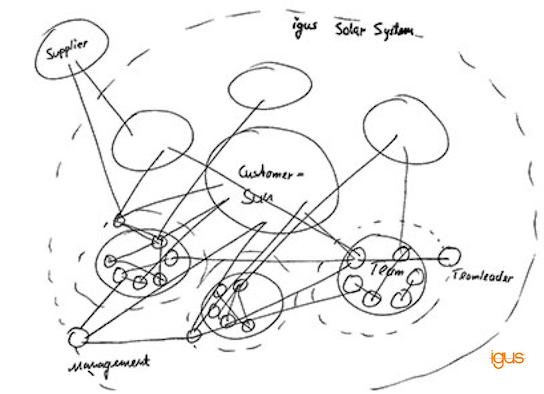Corporate Solar System – Turquoise Organizational Structure
Will we function in completely new types of organizations in five years? In companies where employees are independent, they do not require a supervisor and the structures are far from the traditional hierarchy?

Heraclitus of Ephesus (4th century BC) said, “The only thing that is constant in life is change.” Nowadays, thanks to enormous technological progress and wide access to knowledge, this change is no longer permanent. The changes accelerate much faster than before and are no longer linear, but exponential. The intensive development of our civilization in recent years is largely due to very fast computerization and computerization.
As late as 1943, IBM president Thomas Watson said, “I think there is a market for maybe five computers in the world.” By 1970, there were already 1 million interconnected computing devices and sensors worldwide. In 1980, there were as many as 10 million, in 1990 – 100 million, in 2010 – 10 billion. Internet of Things experts predict that in 2020 the number of connected computing devices, i.e. computers, tablets, TVs, phones and sensors, will exceed 30 billion.
Out of the box
Such rapid technological changes, the Internet, and thanks to it access to global knowledge, cause enormous transformations in people and organizations themselves. They can even become the cause of rapid transformations in the development of entire social groups and generations. When talking to Polish entrepreneurs, it is more and more often heard that there is a shortage of employees: machine operators, engineers, programmers or marketing and sales specialists. Many companies are looking for young talents at universities and offer permanent jobs to students.
In June this year. According to the Central Statistical Office, the unemployment rate in Poland reached 7.2 percent, which is the lowest level in 26 years. On the other hand, the global unemployment rate, according to the International Labor Organization, was 5.7% in 2016, and the problem of the shortage of workers has been known for years, both in developing and developed countries. If we also take into account the social changes taking place before our eyes, the situation on the labor market will worsen even further.
About 20-30 years ago, almost every teenager dreamed of having his own rock band, and the stars were Rysiek Riedel or Madonna. Currently, the dream of this social group is to have its own start-up, and the idols are Mark Zuckerberg or Elon Musk. For the millennial generation to whom the world is open, it is not always obvious to function according to the traditional pattern: sleep-home-work-home-sleep, let alone cramming into the frames: subordinate and superior.
Some managers, especially in traditionally managed companies, do not understand these needs of a generation, which means that these young people do not always engage in their duties. This leads to misunderstandings and a decrease in the efficiency of companies. At the other extreme, we observe a rash of start-ups, new creative products, services and ideas, we also hear news that giants such as Google, Facebook and Amazon are taking over more companies. We notice an increasingly clear difference between the two business models presented. What is it about? And does it only result from the use of different technologies?
The genesis of turquoise
Comparing the activities of companies with different business models, it turns out that the difference most often lies in the organizational culture itself. Many scientists and authors of books have written on this subject more than once. Let’s mention such titles as: “From Good to Great”, “Great by Choice” by Jim Collins, “Maverick” by Ricard Semler or “Working Differently” by Frederic Laloux. Thanks to the latter book, phrases such as “turquoise organizations”, “turquoise management” or “turquoise leaders” are becoming more and more popular.
It was Laloux who systematized the existing knowledge on the evolution of the organization and boldly showed the next stage of its development. Following scientists who study the evolution and psychological development of man, he called this next stage of human and organizational development turquoise. Using the examples of twelve companies from around the world, he showed that the new type of organization has been functioning and has been working very well for years, and the twelve organizations under discussion have common features that differ from other companies. These include: departing from the hierarchical management model, teams that do not require a supervisor and self-management.

Organization atoms
Since my MBA studies I have always been interested in news in the field of team and company management. Since joining igus (2008) as Managing Director (and now as president of igus in Poland), I have been fascinated by the idea of Frank Blase – son of the founder of igus GmbH – to change the traditional hierarchy in the company to a flexible and more efficient responsibility to every employee of the “Solar System”.
I first heard about Frederic Laloux’s book during Agile Project Management training only this year. I reached for it with curiosity, especially because its English title: “Reinventing Organizations” intrigued me and seemed close to my vision of striving for excellence in igus, constantly fighting waste and improving quality, incl. thanks to the implementation of Lean.
However, with each subsequent page read, it turned out that the practices of the twelve companies described in the book are very similar to those that we have been using for years at igus. Building transparency, deep trust between employees, an atmosphere of cooperation and responsibility for each other and for the company are the hallmarks of our everyday life … Open talking about successes and failures in the group forum and learning not to make mistakes together are the everyday work of the entire company in Poland.
Due to the fact that responsibility, decision-making and commitment to the development of the organization is shared by almost all employees and not relying on one president or several board members, both igus and the twelve turquoise companies described by Frederic Laloux are much better at in the present, multipolar and rapidly changing world.
There are many examples of the fact that the distributed decision-making system is more effective nowadays: from our organism composed of trillions, interdependent cells, through our brain consisting of various hemispheres, lobes and parts, with varying degrees of responsibility for our day-to-day operation, to the development of current cities and technology companies.
Real perfection
Research shows that when cities double the size of the city, the average level of innovation per capita increases by 15%. On the other hand, when companies, especially those managed hierarchically, grow, the level of innovation per employee drops dramatically. Our modern cities are not developed by one president or president through their decisions, but we develop them together.
The enlargement of the city consists of millions of individual decisions, made individually by residents, companies, colleges, schools, administrative institutions, and even foreign tourists or investors who visit the city and can reach it from every end of the world. If the same decisions were up to a single president, most of the proposals would be stuck in his email inbox or on his desk for weeks or months. And this is what often happens in traditionally managed, hierarchical enterprises.
This can be changed – there are solutions. I am not saying it will be easy, but we are an example of a company from which a good example can be drawn. There are more and more such organizations, their heads and owners, both in Poland and in the world. In this environment, we are also happy to exchange our own experiences and share best practices. The boss or owner of a turquoise company gains more time and becomes more human, the company becomes more effective, and the work culture is better.
Solar System – Turquoise Organizational Structure

Our company is close to the modern concept of Turquoise Organizations. The hierarchy of positions is only formal, instead of the traditional pyramidal organizational structure, we have the so-called Solar System. It is an organizational structure of the company that, like the three other structures of turquoise organizations described by Frederic Laloux, departs from the traditional, hierarchical, vertical pyramid model.
In our spatial solar system, there is a customer in the very center, and various departments that make up the company circulate around the customer: from sales, through production, to accounting and software development. The name Solar System is synonymous with the Solar System. In the Solar System, the Sun is in the center and gives the Earth heat, energy, light, just like the center of the Solar System is the customer who gives our company orders, ideas for new products, money thanks to which the company can exist, Just like the Earth would not survive if The sun would suddenly go out, and our company would not survive if customers suddenly stopped buying the company’s products and services.
In the Solar System, employees from individual departments are closest to the customer and can make autonomous decisions to provide the best customer service. For important costly decisions, they may consult teammates or Product Managers, not necessarily me. For years, the company has been using slogans such as: “everyone is a manager” – which each employee understands that he can make decisions and successfully complete the task. Over the years during which I have employed and trained new employees, because the company is developing very quickly, I have always paid attention to building a culture of entrepreneurship – one in which every employee feels responsible for their area of activity and the client is always the direct supervisor.
Avoiding showing hierarchy and using phrases in the company such as “boss”, “director”, “president”, we provide an open and friendly atmosphere in which everyone is at “you” and communication and cooperation is based on trust and not the order and control system. None of the managers, including the president, has a private office. They all sit in an open space, at the same desks, and we work in an atmosphere of support and transparency. The working environment is completely open, facilitating meetings, using the same equipment and sharing the same canteen.
Frederic Winslow Taylor once said: “A total mental revolution is needed, both on the part of the worker and on the part of the management.” Are the words of the father of modern management science still valid and the mentioned revolution awaiting us soon? Or is it an evolution that is slow and therefore difficult for you to notice?


No comment yet, add your voice below!